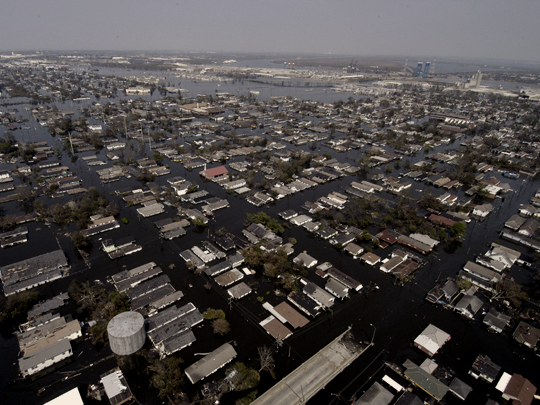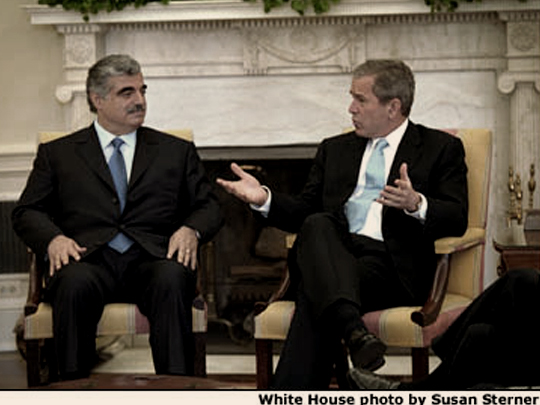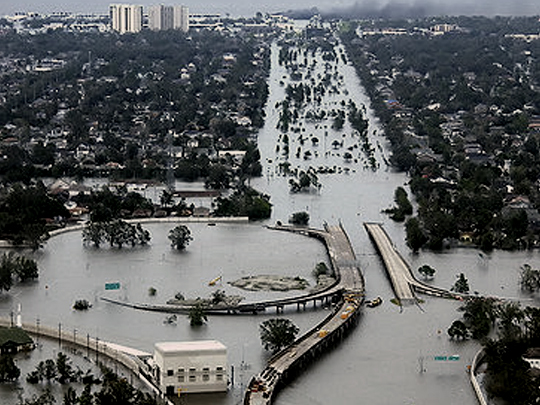AP Photo/U.S. Coast Guard, Kyle Niemi / Wikimedia Commons / CC-BY-SA-3.0 / GFDL
1 – Hurricane Katrina Devastates New Orleans in the U.S.
Hurricane Katrina was an extremely destructive Category 5 hurricane that made landfall on Florida and Louisiana in August 2005, causing catastrophic damage, particularly to the city of New Orleans and the surrounding areas.
Subsequent flooding, caused largely as a result of fatal engineering flaws in the flood protection system known as levees around the city of New Orleans, led to most of the loss of lives.
The storm originated over the Bahamas on 23 August, strengthening into a hurricane shortly before making landfall in Florida on 25 August.
After briefly weakening to a tropical storm, Katrina strengthened into a Category 5 hurricane over the warm waters of the Gulf of Mexico before making its second landfall as a Category 3 hurricane on 29 August, over southeast Louisiana and Mississippi.
Over 1,800 people died as a result of the hurricane and subsequent floods, making Katrina the deadliest hurricane in the U.S. since the 1928 Okeechobee hurricane.
Severe property damage occurred in coastal areas, where boats and casino barges rammed into buildings in beachfront towns, cars and houses were pushed inland, and water reached up to 12 miles from the beach.
The total property damage was estimated at $125 billion, tying Katrina with Hurricane Harvey of 2017 as the costliest Atlantic tropical cyclone on record.
Over fifty breaches in surge protection levees surrounding the city of New Orleans, Louisiana was the cause of the majority of the death and destruction during Katrina. Approx. 80% of the city was flooded, with the floodwaters lingering for weeks.

The scale of the disaster in New Orleans provoked massive national and international response efforts. Rescue operations evacuated displaced persons out of the city over the following weeks.
There was widespread criticism of the emergency responses from federal, state and local governments, resulting in the resignations of Federal Emergency Management Agency director Michael D. Brown and New Orleans Police Department Superintendent Eddie Compass.
Many other government officials were criticized for their responses, especially New Orleans Mayor Ray Nagin, Louisiana Governor Kathleen Blanco, and President George W. Bush.
Meanwhile, agencies such as the United States Coast Guard, National Hurricane Center and National Weather Service were commended for their actions.
2 – London Bombings

The 7 July 2005 London bombings were a series of coordinated Islamist terrorist suicide attacks in London, England.
The bombs targeted commuters traveling on the city’s public transport system during the morning rush hour.
Four radical Islamic terrorists detonated three homemade bombs in quick succession aboard London Underground trains. A fourth bomb was detonated on a double-decker bus in Tavistock Square a short time later.
The train bombings occurred on the Circle line near Aldgate and at Edgware Road, and on the Piccadilly line near Russell Square.
52 people were killed in the attacks, excluding the 4 bombers, with another 700 people injured in the attacks.
It was the country’s first Islamist suicide attack and England’s deadliest since the 1974 Birmingham pub bombings. The attacks occurred the day after London had won its bid to host the 2012 Olympic Games.
The bombings were followed two weeks later by a series of attempted attacks that failed to cause injury or damage.
By 29 July, police had arrested all four of the main bombing suspects from 21 July attempted bombings.
The men were found guilty of conspiracy to murder and were each sentenced to life imprisonment, with a minimum of 40 years’ imprisonment.
3 – Assassination of Lebanon’s Rafic Hariri

On 14 February 2005, Rafic Hariri, the former Prime Minister of Lebanon, was killed along with 21 others in an explosion in Beirut.
Approx. 1,000 kilograms of TNT were detonated as his motorcade drove near the St. George Hotel. Among the dead were several of Hariri’s bodyguards and former Minister of the Economy, Bassel Fleihan.
Hariri had been the Prime Minister of Lebanon from 1992 to 1998 and again from 2000 until his resignation on 20 October 2004.
He is widely credited for his role in helping to end the 15-year Lebanese Civil War and reconstructing the capital Beirut.
According to an independent investigation, carried out by brigadier general Wissam Al-Hassan, of the Lebanese Internal Security Forces, compelling evidence was found that the Lebanese group Hezbollah was responsible for Hariri’s assassination.
Four Hezbollah members were indicted for the assassination and tried in absentia by the Special Tribunal for Lebanon, but others have linked the assassination to the Syrian government.
Hariri’s assassination was a catalyst for political change in Lebanon, with huge protests helping to achieve the withdrawal of Syrian troops and security forces from Lebanon and a change of government.
On 19 October 2012, brigadier general Al-Hassan was assassinated in a car explosion in Beirut.
He had been the heart of Lebanon’s security and stability and was regarded as a key figure in keeping the investigation ongoing.
4 – YouTube is Launched

YouTube is an American video-sharing website headquartered in California, founded by three former PayPal employees, Chad Hurley, Steve Chen, and Jawed Karim in February 2005.
Google bought the site in November 2006 for US$1.65 billion; YouTube now operates as one of Google’s subsidiaries.
As of February 2017, there were more than 400 hours of content being uploaded each minute, and one billion hours of content being watched every day.
According to Alexa Traffic Rank, in August 2018 YouTube was ranked as the second-most popular site in the world.
